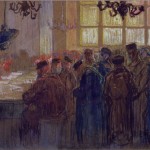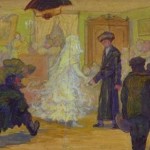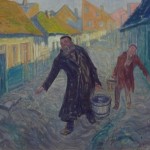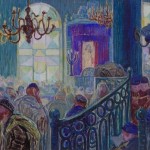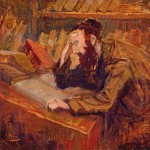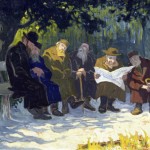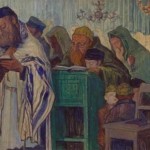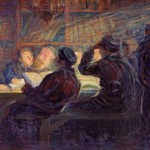Moshe Rynecki (1881-1943) was an artist who painted scenes of the Polish Jewish community in the interwar years. He had a keen eye for exploring and documenting the daily rhythm and life of synagogue, teaching, labor, and leisure. His work is made rarer and more precious by documenting the nuances of both a way of life and a place that were irrevocably destroyed by the crushing impacts of World War II and the Holocaust.
At the outbreak of the Second World War, Moshe became concerned about preserving his life’s work. In the early days of the war he made the decision to divide his oeuvre of approximately 800 works into a number of bundles, and to hide them in and around Warsaw. He gave a list of the locations where the works were hidden to his wife, son, and daughter, in hopes that after the war the family would retrieve the bundles and the collection would be whole once again. Moshe willingly went into the Warsaw Ghetto, desiring to “stay with his people,” and perished in Majdanek. His daughter was murdered in the Warsaw Ghetto. His wife, his son George, George’s wife Stella, and their young son Alex hid in a number of locations outside the Ghetto and, despite a number of very close calls, ultimately survived the war.
After the war Moshe’s widow went to see if any of the bundles of paintings survived. She found just a single package in the cellar of a home in Warsaw’s Praga district, across the river Vistula. Of the find, Moshe’s son George wrote in his memoir, “The paintings seemed to have gone through the same fate as the Jewish people – massacred and destroyed. About 12–15 percent of Jews survived the Holocaust. So did my father’s paintings. One hundred and twenty were found out of a count of close to eight hundred works.”
For many years the Rynecki family believed that just this single bundle survived. Fortunately, that was not the case—many more pieces survived, and Moshe’s great-granddaughter Elizabeth has found a substantial number of previously “lost” works over the last several years. This story is a visually rich exploration that spans nearly a century – from the time a young painter started painting and drawing images of the Jewish community over his father’s objections, to his great-granddaughter’s ongoing search for her family’s legacy of lost, missing, and looted paintings. The book chronicles the many dead-ends, failures, hopes, and triumphs of her efforts to learn the stories of the missing paintings and the people whose lives they have touched. It traces her efforts to rediscover the collection, struggling with the balance between being historian and claimant. Ultimately, she seeks to piece together the fragments of the vanished culture portrayed in the paintings, hoping to find in them the echoes of her great grandfather.
- Water Carriers, 1930
- The Reader, no date
